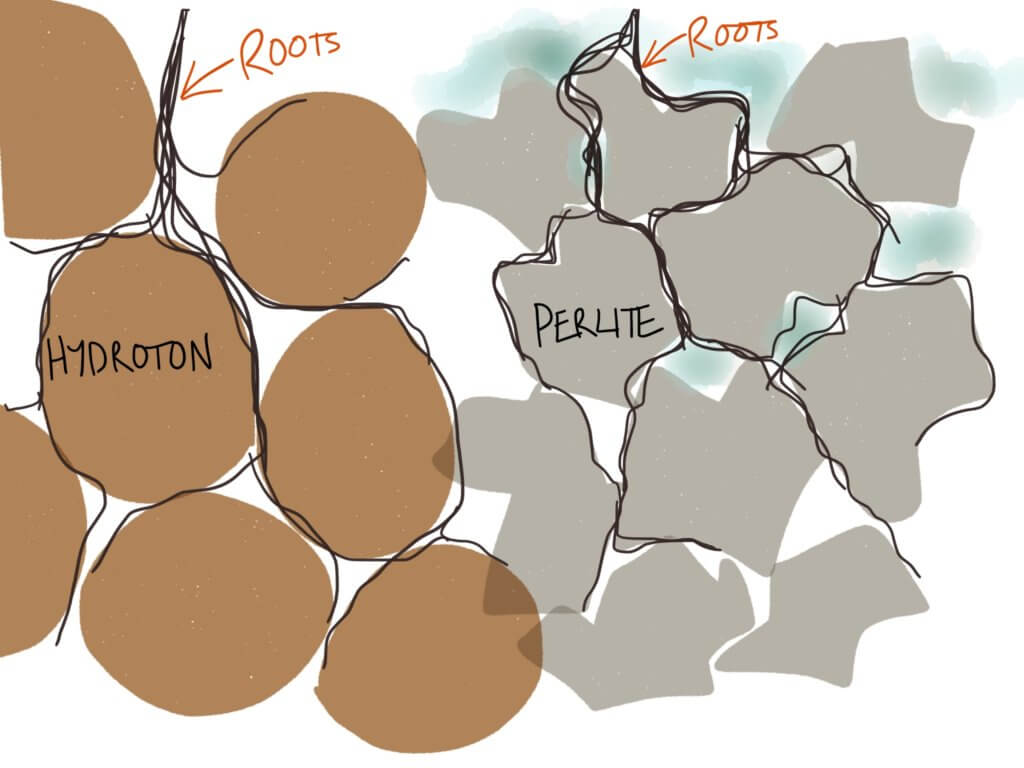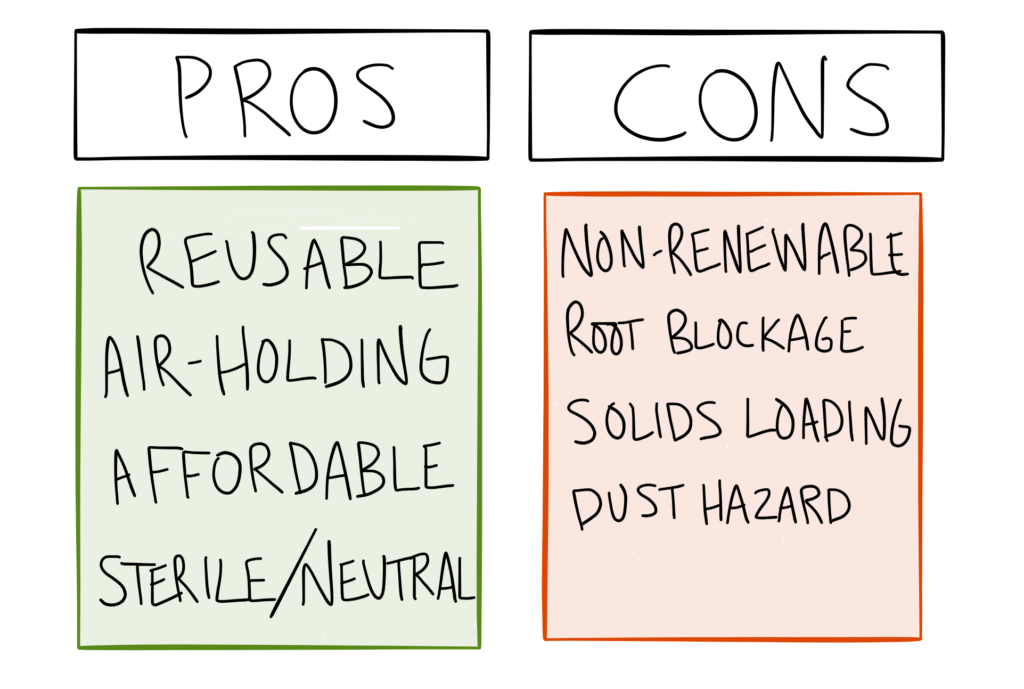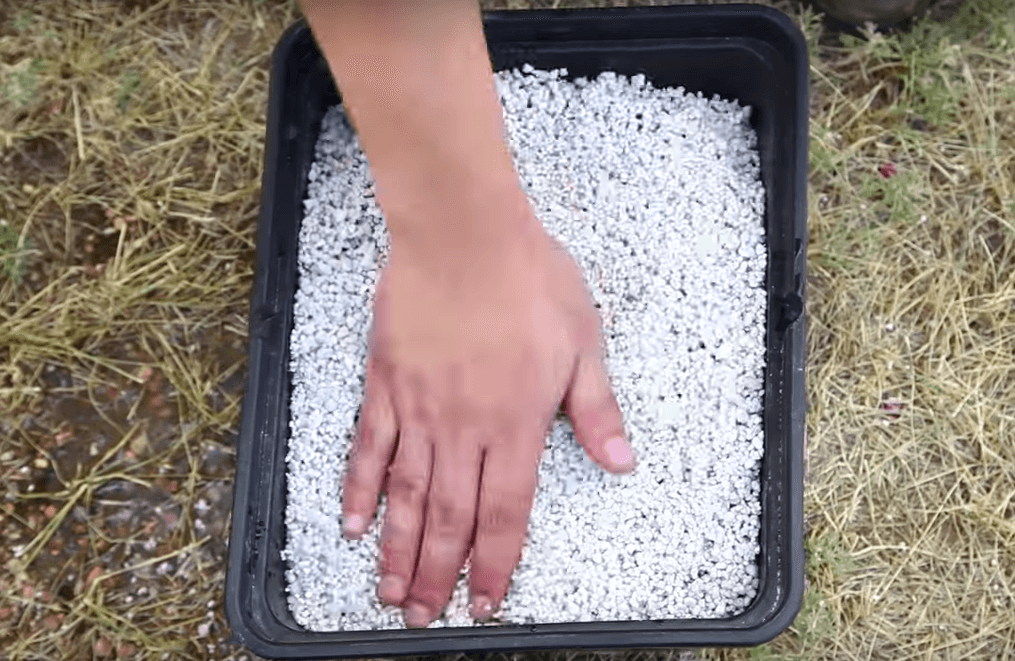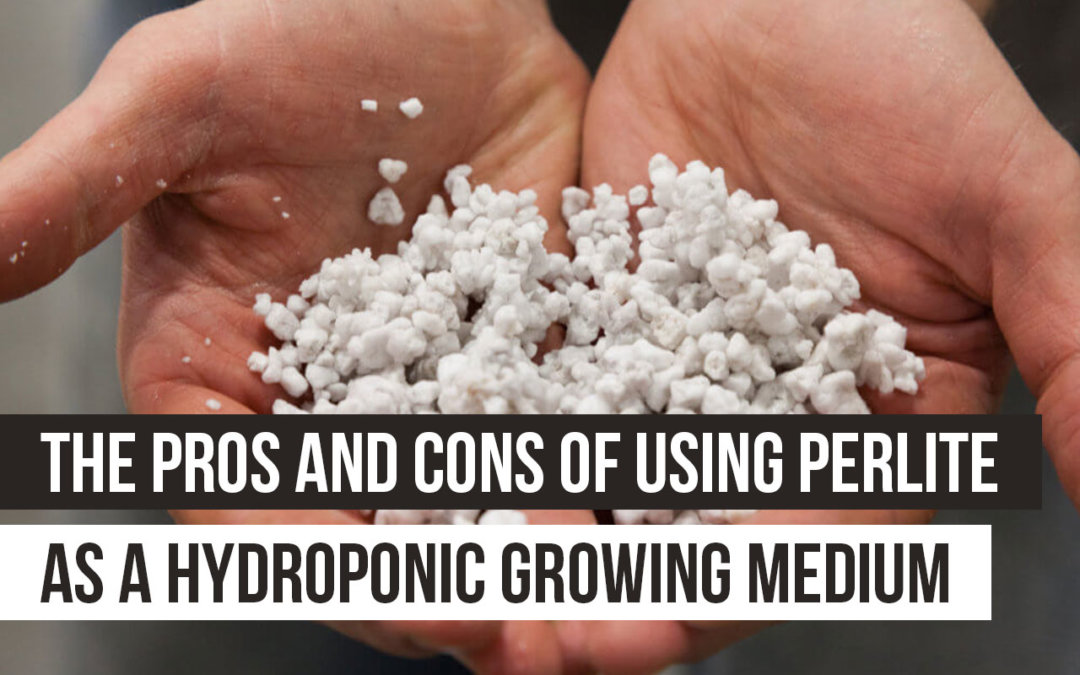What is perlite?
Perlite is ore that has been superheated in a kiln until it expands like popcorn. This makes it very lightweight and gives it air holding capacity—a real benefit for growers trying to keep root zones aerated.
Perlite has been used for decades in insulation, cement, and building materials, but recently has been used more and more for things like filtering and as a growing substrate. Many hydroponic growers use perlite as their primary medium (especially if they’re growing in Bato or Dutch buckets).
That said, there are both pros and cons to using perlite in hydroponics. Growers should choose a medium based on how much it weighs, how easy it is to handle, how it impacts system pH and diseases, the size or texture, etc.
Read on to get details on the pros and cons of perlite.
Pros & Cons of Perlite
Pros of perlite
1) Perlite is usually reusable.
The only time you might throw perlite away is if you have a very bad disease problem and no good way to sterilize it.
If you have a bad infection of something like pythium, then you’ll definitely want to wipe out any inoculum (the infecting part of a disease, for example, the spores) before using that media with new crops. You can sterilize the media with heat (using a rented soil sterilizer) or chemically with a hydrogen peroxide solution or bleach solution (remember to rinse it extremely well if using bleach).
2) Perlite helps deal with anaerobic conditions.
Because perlite holds air so well and because it’s a coarse texture, it can do wonders for systems dealing with oxygen issues. A lack of oxygen in water, soil, or anywhere that there are roots growing (the root zone) causes anaerobic conditions. This allows for anaerobic bacteria (decomposers) to come in and start doing their thing. Since their thing is decomposing, this is very bad news for plant roots. The point is: avoiding anaerobic zones is crucial!
Growers can avoid anaerobic zones by keeping the water oxygenated (use correct flow rates, turbulence, and air stones) and avoiding build-up and compaction in the growing medium. Perlite is a huge help in this area, as the large particle size not only provides air pockets and has no compaction problems, but actually has some oxygen-holding capacity and exchange.
3) Perlite is inexpensive.
You can get 4 cubic feet of perlite for $14 dollars at a hydroponic or greenhouse store (or online), while other sterile pH-neutral media, like hydroton, can cost nearly twice that. Since most applications (in soilless mixes or in systems like Bato buckets) use a relatively small amount of the medium, perlite is fairly cost-effective.
4) Sterile and pH neutral
Some soilless media must be sterilized before being used to avoid the introduction of pests and diseases into the system. Since perlite is not sourced from an organic source (similar to coir and peat) and has been sterilized in the creation process (being superheated), it has had almost no chance for bacterial, fungal, or insect pests to get into it. This helps you avoid pest problems!
Perlite is also pH neutral, unlike some media like expanded shale and rock wool. Those types of media can be mildly basic, which influences system pH and complicated pH dosing. A neutral media can be much more convenient and better for long-term system health.
Cons of perlite
1) Perlite ore is not a renewable resource.
There is only so much ore in the world. Although it will eventually renew, it’s not renewable in human time. That said, we don’t use that much of it relative to all that is there (in 60 years we’ve used less than 1% of the world’s perlite ore) and it’s inexpensive. You’ll have to weigh the pros and cons of that to decide whether you think this is sustainable or not.
2) Aggressive root systems can cause blockage.
With large aggregates like hydroton, plant roots growing down into the pore space isn’t going to affect the percolation much. After all, there’s pore space to spare between the fairly large particles.
Perlite, on the other hand, is composed of smaller particles. This means that when plants with an aggressive root system (either very mature plants or plants like mint and chives with lots of roots) extend into perlite, the pore spaces can get mucked up and blocked.

Roots can fill up small pore spaces (like those in vermiculite), causing clogging, debris build-up, and pooling water.
3) Vulnerable to solids loading
In addition to being filled with plant roots, the air pores in perlite can capture solids like algae, debris, and biofilm, with a similar result: blocked percolation.
This isn’t typically a big issue unless the system is quite dirty or is being run on an organic hydroponic solution. This type of solution relies on a robust community of microbes to cycle nutrients, and so a much thicker biofilm will form on the surface of the substrate.
4) Dust hurts fish and can be hazardous if inhaled.
Don’t use perlite with fish! If you look at perlite under a microscope, it looks like a collection of small glass bubbles. And in fact, that’s what it is. That means that although picking up perlite with your hands won’t cut you, it is abrasive and can cause real damage to soft sensitive tissue—like the gills of a fish, and your throat and lungs!
That being said, don’t use perlite in any aquaponic operation. Wear a mask or respirator when you’re handling dry perlite to avoid breathing in perlite dust. Once it’s wetted down, the dust shouldn’t be a problem.

What can you use perlite for?
 Perlite’s uses in agriculture are growing more diverse, especially as hydroponic growers experiment with the media. Perlite is primarily used as an additive to potting mixes and as a hydroponic media in systems like Bato bucket systems.
Perlite’s uses in agriculture are growing more diverse, especially as hydroponic growers experiment with the media. Perlite is primarily used as an additive to potting mixes and as a hydroponic media in systems like Bato bucket systems.
Want to use perlite in Bato buckets? Bato buckets are the method used for larger vining crops like eggplant and tomatoes and are a great way to get started in hydroponics.
You can learn how to build an 8-bucket Bato system here.



What would be the best media for Spearmint (Hydroponic)?
Hi David, what type of system are you using (media beds, Bato buckets, ZipGrow, etc) and where are you located?
Sorry, if it will be soaked most of the time in aquaponics; then why can’t I use it. there will be no dust!. Is that right ?
Hey Ibraheem, with aquaponics the dust issue is due to it being in the water. Fish gills are very sensitive and the rough perlite dust can cut them, causing stress and discomfort – and in many cases, fish death.
Hi Amy,how fine are the dust particles, would a 130 micron inline filter be sufficient to prevent harm to fish, I ask because I am planning on trailing micro greens grown in perlite in my aquaponic system
Hey Chris, probably not. Better play it safe and use something else. Soil would work fine and we’ve had good luck with hemp mats.
What about using coco coir and perlite mix 1:1, mixture held in a nylon mesh bag used over a layer of hydroton filled base reservoir in a dutch bucket system. Also oxygenated nutrient film may be added by drip to the plant i the dutch bucket. Pls advice if this may work well.
What size perlite should I use to plant tomatoes in dutch buckets (hydroponics)
Hey Tim, 3 mil is pretty standard. A lot of the perlite products out there won’t even have sizing on them, though. Both Hort Americas and CropKing offer perlite, if you’re looking for some.
Can one mix coco peat and perlite in a Bato bucket to achieve a reasonable results for tomatoes?
Hi there—that ought to work just fine!
I am using perlite in two ways: Dutch bucket and concrete mixing tubs. I haver algae growing on the perlite, especially in the tubs. I can’t fully cover the media to block light from the perlite, but the rest of the system is blocked from light. Any suggestions on how to deal with the algae?
Hi,
How do you sterilize perlite for re-use?
Can I use this in a hydroponic system
Finally fixed pperlite from plugging my hydrophonic drains. Hope this helps some members. Have 16 buckets on 4 shelves. That rice kept plugging up the drain lines. I went to hdwe store and purchased clear tubing to go over the pvc pipe. Took a dremil tool and drilled many holes in both sides of the pipe. I purchased 5 gallon painters screen for paint. Cut that for over the one eight holes. Used hot melt glue gun and bonded the fabric to the clear plastic. Much more area for it to drain. Pump shuts off, the perlite sinks fast. The end one i used a garden barb with a screen. You can cut and drill however much you like. I used 6 inches on both pipes. No more plumbing problems. Yippee